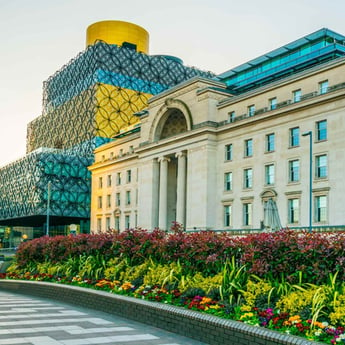Birmingham - From 1989 to 2049

MIPIM 30th anniversary blog from Carl Potter
As MIPIM celebrates its 30th anniversary this year, it seems appropriate to take a moment to appreciate how Birmingham’s development has changed over this period.
In 1989, the most transformational and potentially impactful development in Birmingham’s history was midway through development. Occupying a site between Centenary Square and the canal basin, the International Convention Centre – incorporating the unique Symphony Hall – was just two years away from completion.
Fully completed in June 1991 at a total cost of some £200 million, the building was a cornerstone of the city’s transformation and the first step in a metamorphosis from the concrete-laden industrial maelstrom of the past, towards today’s well-regarded, innovative and contemporary 21st Century metropolis.
The ICC also acted as a significant catalyst, opening the door to the future development of the city’s burgeoning Westside, which led to the delivery of the Brindleyplace estate, Birmingham Arena, and Arena Central.
Throughout the intervening years, Westside has been constantly recognised as one of the city’s most important growth areas, enabling the delivery of new hotels, residential apartments, and business and leisure amenities.
Importantly, Westside has acted as a conduit, connecting the city core with Calthorpe Estate’s plans for a rejuvenated and reinvigorated Edgbaston including the widely anticipated New Garden Square development.
This connection will continue to be strengthened through the ongoing extension of the West Midlands Metro tram and the reimagining of Broad Street, with an increase in higher-end bars and a plethora of top-tier city living options.
Today’s city has become unrecognisable from the Birmingham of 30 years ago, both physically and in terms of its outlook – the formerly ubiquitous Brummie self-deprecation is less evident than it used to be – and it is now in perhaps its strongest position ever in terms of attracting and retaining talent, inward investors, and large-scale HQ operations.
This attractiveness as a city and city region that offers a diversity of opportunities to live, work and socialise, has been recognised by a huge growth in the tourism industry which, in 2017 amounted to 41.8 million visitors, a nine per cent increase on the previous year.
Working on the basis of this growth trajectory, by the time that MIPM celebrates its 60th anniversary, Birmingham will represent a significantly different proposition.
Developing the past principles of advanced manufacturing and building on the city’s growing faith and belief in itself, Birmingham will be a hub of creative forces built around digital technologies that will redefine the industry types that themselves proliferate a changing world.
Within the city itself, the Westside area will continue to strengthen, with the City Council’s residential-led plans to regenerate Ladywood playing a key role in further enhancing the connectivity of the city centre and Edgbaston.
To the east, the HS2 terminus at Curzon Street and expansion of the tram out to Digbeth will be playing a fundamental role in reshaping that side of the city, with the landmark Smithfield development acting as a significant bridge between these two important parts of the city.
Both the Custard Factory and Innovation Birmingham campus – the latter of which is due to see significant investment from Bruntwood – will support digital and technology clusters, encouraging more creatives to the city.
The difference in Birmingham from 1989 to now is significant, but the city is now in a position to ensure that the next 30 years bring even more significant changes.
